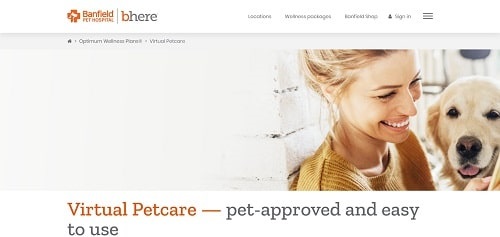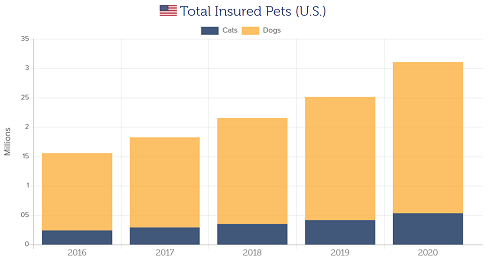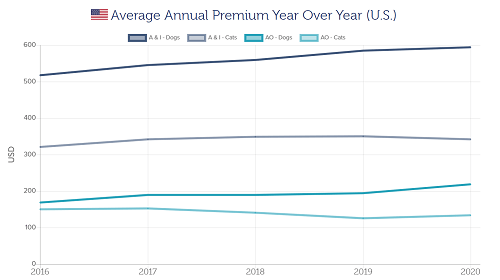Across the globe, almost 845 million dogs and cats have a home, though dogs are, by far, the most popular non-human family member in the world.1 More than half of homes in the U.K. and France cater to at least one pet.23 Just under half of Italian households have a dog or cat, while just shy of 10 percent of them provide homes for domesticated birds or turtles.4
In the European Union overall, there has been an increase of roughly 15 million domesticated animals living in homes over the last ten years.5 Canadians house roughly 15.8 million dogs and cats, while Brazil has the most pets of any Latin American country, with 141.6 million total as of 2019.67 Dogs are the most favorite pet in Brazil, but birds and cats come in second and third, respectively.

And in the U.S., 70 percent of homes have a pet, hopefully lounging around on comfy furniture, amounting to about 90.5 million households. Dogs occupy 69 percent of those homes, while cats rule the roost in about 45 percent of them, followed by fish, birds, and other small animals.8
The Millennial generation leads the way in pet ownership, reaching 32 percent, while Baby Boomers and Generation X make up 27 percent and 24 percent of pet ownership in the U.S., respectively.9
With all the pets in the world, the state of pet healthcare is some matter of importance. We know pets are beneficial to our health, so what are we doing for their health?10 In the U.S., the pet industry as a whole saw over $100 billion in sales in 2020 with veterinarian care being one of the greater expenses. Overall spending on our pets also rose above the previous year, led by horse owners and then dog owners.11
In Canada, 75 percent of pet owners went to their veterinarian to learn about different types of pet care, and in the U.K., about 3.4 million pets had health insurance in 2019, with veterinary expenses and other pet care services reaching 3.99 billion GBP.121314
Looking for something specific? Click on our sections below to jump around.
- Pet Healthcare Overview
- Common Reasons for Vet Visits
- Pet Health Insurance
- Pet Healthcare Spending
- Food, Treats, and Supplements
Pet Healthcare Overview
Around the world, people love their pets and aim to take care of them the best they can. During the pandemic, most pet owners became more aware of their pets’ needs and subsequently, pet healthcare has become a booming business. According to Banfield Pet Hospital, 2020 pet healthcare trends showed an increase in the total amount of veterinary visits, particularly among younger dogs and cats, along with a rise in issues related to accidental injury and mobility-related ailments. The online vet chat offered through the hospital’s website experienced double the daily volume of interactions during the pandemic compared to previous years.15

Screenshot via Banfield.com
Believe it or not, birds visit the vet the most – three or more times per year. Dogs also visit the vet frequently, averaging between two to three times per year. 69 percent of those dogs have an appointment for a routine checkup. More than half of dog owners stated vaccines, especially the rabies vaccine, was the main reason for the checkup.16
Spay and neuter is a popular option in the U.S., with more than 75 percent of dogs having undergone the procedure. This number has dropped from 85 percent, though, since 2016.17
Only about 10 percent of dog owners in the U.S. carry health insurance for their pets.18 However, in the U.K., more than half of pet owners have pet health insurance for their non-human family members. Roughly 85 percent of U.K. dog owners also get their dogs wormed and vaccinated, while about 70 percent have their dogs spayed or neutered. More than 90 percent of U.K. dog owners get their dogs microchipped and registered with their veterinarian.19
Common Reasons for Vet Visits
What caused the surge of vet visits? Due to lockdowns during the pandemic, people became more aware of their pets’ daily habits, which might have contributed to the rise. But what were the top reasons for taking their pet to the vet, especially when some locations were likely closed or offering reduced services? Stress, less-than-optimal nutrition, and inactivity ranked high among the reasons for vet visits.
The most common ailments for dogs and cats were centered around weight gain, obesity, and mobility issues, particularly osteoarthritis, which can reduce a pet’s activity by up to 30 percent.2021 But Banfield Pet Hospital also noted an uptick in complaints related to skin allergies, digestive issues, fear, anxiety, and overall malaise.22

Specific to cats, the hospital also reported an almost 50 percent increase of felines displaying fear and anxiety.23 And 70 percent were diagnosed with a form of dental disease. Just over 30 percent of the furry felines were obese.24
Other common health issues for cats included intestinal parasites and external parasites such as fleas and ticks. However, there was a low prevalence of environmental allergies and heartworm.25

Specific to canines, Banfield Pet Hospital found just over 75 percent of dogs have some form of dental disease and more than 30 percent are overweight or obese.26 The most common reasons for vet visits were arthritis, intestinal parasites, fleas and ticks, and environmental allergies.
Also on the rise is bloat – Gastric Dilatation-Volvulus (GDF), which occurs when the stomach fills with air and twists or flips, cutting off blood supply – a diagnosis which has dramatically increased since the 1960s.27 The hospital recorded a low prevalence of diabetes, heartworm, and kidney disease.28
Pet Health Insurance
Health insurance for animals started as far back as 1890, with insurance plans typically laid out for horses and livestock. Roughly 100 years later, in 1982, health insurance for domesticated pets, such as dogs and cats, was born. Offered throughout North America, there are roughly 20 large pet insurance companies that handle the majority of insurance plans. Some of the major pet health insurance companies include Trupanion, Petplan Insurance, Petsecure, Embrace Insurance, and Nationwide.
The North American Pet Health Insurance Association is the main governing body of all pet health insurance companies for both the U.S. and Canada.2930

Screenshot via Naphia.org
There were nearly 3.45 million pets insured with a North American pet health insurance company in 2020.31 In Canada, more than 350,000 pets had pet health insurance, of which 265,000 were dogs. In the U.S., canines composed more than 80 percent of insured pets.32

Screenshot via Naphia.org
The veterinary industry has been an ongoing, increasing success, experiencing a growth rate of almost 25 percent in the last five years. In the U.S. In 2020, veterinary care and product sales, including routine and preventative care, surgery, and medications, tallied $31.4 billion and reached $32.3 billion in 2021.3334
In the year 2020, the total premium volume for pet health insurance in the U.S. was nearly $2 billion, a four-fold increase from $500 million in 2013.35 Overall, the dogs with the lowest insurance rates were Beagles and German Shepherds, and the lowest health insurance rates for felines belonged to exotic breeds.36
In the U.S., the average 2021 monthly insurance premium for a Golden Retriever was $40.56, compared to Beagles and German Shepherds which had an average monthly cost of $34.32.37 But the average annual pet health insurance rate for American canine breeds who were signed up for accident and sickness plans was $594.15.38 For our furry felines, the average annual pet health insurance rate was $341.81.39

Screenshot via Naphia.org
In 2021, Canadians paid out a total of 244.6 million CAD for pet health insurance premiums.40 Annually, this amounted to about 767.45 CAD for pet owners whose dogs were covered by an accident and sickness insurance plan, though the average puppy health insurance plan was roughly 1,100 CAD per year.41 For owners of cats, accident and sickness pet health insurance premiums cost 369.14 CAD per year.42
Pet Healthcare Spending
Pet healthcare is a priority for lots of pet owners. Our pets deserve the best, and we spend a lot of money on them. From food to toys and everything in between, humans shower their furry, scaly, feathery friends with trips to the groomer, daycare, and more, in order to enhance their well-being. The pet industry boasts sales of about $100 billion and is expected to grow to about $275 billion by 2030.43
Pet care services such as grooming, dog walking, daycare, dog training, and pet health insurance are expected to grow over the next few years, reaching $16 billion in sales by 2025.44 The average pet owner spends anywhere from $500 to $1,500 a year on their pets.45 And more than half of pet owners knowingly and willingly take on debt to pay for veterinarian bills.46
What are we spending at the vet? The data from 2020 shows:

- The average dog owner spent $241 on veterinarian services, including vaccines, per year.47
- Dog owners spent an additional $62 to pay for pet health insurance.48
- For some dog owners, surgical veterinary visits equaled another $458 a year.49
- Cat owners spent $125 a year for vet services.50
- The average cat owner spent $57 for pet health insurance.51
- For some cat owners, surgical veterinary visits equaled another $201 a year.52
With an increase in veterinary visits for ailments that are on the rise, the pet pharmaceutical industry is also experiencing growth. The pet medications market reached $10.8 billion in sales in 2020, which is up about 13 percent from the previous year. Medications included prescriptions as well as over-the-counter items such as parasite preventatives, cancer drugs, and first-aid products.
About 70 percent of all pet medications were purchased specifically for canines. More than 70 percent of all pet medication sales came directly from a veterinarian’s office. Due to the pandemic, online sales also increased, accounting for about 16 percent of retail pet medication sales.53
With many pet parents dedicated to giving their pets the best up until the end, at-home, end-of-life veterinary care is a pet care service that has seen an increase over the last five years. This business generates roughly $217 million annually.54
Likewise, we want to remember our pets forever. As more pet owners look to memorialize their furry family members, pet cremation services have expanded over the last five years to a $668 million industry.55
Other pet care services were booming as well – professional grooming is an $8 billion business and is expected to grow.56 Doggie daycare generates about $4.5 billion a year, while dog walking makes roughly $1 billion every year.5758 Fun fact – Europe has the most active dogs in the world, with the fittest dogs living in Switzerland.59
Food, Treats, and Supplements
Pet food and treats are the largest income makers for the U.S. pet industry, followed by veterinary care and products. Pet food sales totaled more than $44 billion in the U.S. in 2020, with roughly $12 billion of that attributed to dry kibble and wet canned food.60 Pet owners spent an average of $442 per year on dog food and $329 a year on cat food.61
Pet healthcare starts with food. Yet only half of American pet owners consider healthy and nutritious food for their pet to be important.62 And still, only 30 percent of pet owners purchased pet food for their pet’s overall health. Under 20 percent bought pet food specifically for skin and coat, digestion, joint health, dental health, and heart health.63 That said, the search volume for low-calorie pet food on Amazon rose by 113 percent between April 2020 and March 2021.64
While 35 percent of pet parents feel that organic is best, less than half of pet owners buy premium pet foods. According to Pet Food Processing, there is growing interest in freeze-dried and frozen pet foods, as well as fresh and refrigerated pet foods and meal enhancers, based on research conducted by NielsenIQ. The fastest growth is occurring in refrigerated and fresh pet foods, which grew by 20.7 percent in 2020 and accounted for $78.3 million in sales – still, these categories comprise just 1 percent of the market.65
Dehydrated pet foods was the highest revenue earner among freeze-dried, frozen, fresh, and refrigerated pet foods, and meal enhancers, accounting for $304.3 million in sales and growing by 10.7 percent in 2020. Dehydrated pet foods make up 3.5 percent of the pet specialty market. Sales of freeze-dried pet foods reached $239.9 million, while frozen pet foods reached $236.1 million, with both categories making up 2.8 percent of the market.66
Frozen pet foods grew by 14 percent in 2020, while freeze-dried pet foods are experiencing slower growth with just 7 percent growth over 2019. Finally, sales of meal enhancers grew by 5.9 percent in 2020, reaching $165.5 million in sales and making up 1.9 percent of the pet specialty market.67
Despite growing interest in specialty pet food categories like fresh and refrigerated pet food, only one out of five pet owners cook a homemade meal for their furry friends.68
Americans love to give their furry friends treats in between meals. Pet treat and chew sales reached nearly $8 billion in 2021 and is expected to double by 2025.69 Dog treat sales far exceed cat treats, with dog owners favoring treats with high nutritional content. Pet owners purchased more alternative protein or vegetarian options, while more than half of pet owners showed interest in plant-based treats.70 About one-third of pet owners prefer to give their dog a bone.71
In keeping up with pet healthcare, supplements such as glucosamine, omega fatty acids, and CBD oil are also on the rise. Pet owners prefer to give their pets natural and organic products. Dog owners purchased the most pet health supplements, spending about four times the amount that cat owners do. Just under 40 percent of dog owners and 34 percent of cat owners believe CBD supplements are good.72
Just 11 percent of dog owners and 8 percent of cat owners actually gave their pets CBD supplements.73 Of those who did, 48 percent gave the CBD supplement in edible form, typically via pet treats, and 15 percent used tinctures.74
While pet healthcare trends are changing, there’s one thing that remains constant: we love our pets and want them to live happy, healthy lives for as long as possible. With more pet parents purchasing pet insurance and interest growing in specialty foods like fresh and refrigerated pet foods, many pet owners are taking steps to ensure their pets’ well-being.
If you’re interested in your pet’s health, we have a load of resources that can help.
One set of guides is our collection of buying guides which can help you find great waterproof dog beds, outdoor dog beds, elevated dog beds, or dog beds for the couch.
You can also check out our dog weight calculator, dog growth charts including our goldendoodle weight chart, great dane weight chart, chihuahua weight chart, labrador weight chart, and golden retriever weight chart (and our general overview of the how heavy a dog should be), buying guides for important products like the escape proof dog harnesses (read our review of escape proof dog harness) and our list of foods dogs can’t eat and our article on how long it takes for a dog to digest food.
Beyond that, if you’re looking for additional resources to help keep your puppy healthy and looking good we also have a series of buying guides to help you select the best dog ear cleaners, the best professional dog clipper, the best dog clipper for poodle hair, and our guide to finding the best Australian Shepherd dog brush.
Article Sources
Pet News Daily uses only high-quality sources, including peer-reviewed studies, to support the facts within our articles. Read our editorial process to learn more about how we fact-check and keep our content accurate, reliable, and trustworthy.
- Bedford E. Global Dog and Cat Pet Population 2018. Statista.com. Published March 10, 2020. Accessed February 21, 2022.
- Rudden J. Number of Individuals with Pet Insurance in the United Kingdom (UK) 2013-2019. Statista.com. Published January 11, 2022. Accessed February 21, 2022.
- Statista Research Department. People Having a Pet In France 2020 by Type. Published February 7, 2022. Accessed February 21, 2022.
- Statista Research Department. Consumer Behavior of Pet Owners in Italy – Statistics and Facts. Statista.com. Published August 18, 2020. Accessed February 21, 2022.
- Bedford E. Number of Dogs in the European Union 2020, by Country. Statista.com. Published July 8, 2021. Accessed February 21, 2022.
- Number of Cats and Dogs in Households in Canada in 2020. Statista.com. Accessed February 21, 2022.
- Statista Research Department. Pet Care Industry in Brazil – Statistics and Facts. Statista.com. Published December 16, 2021. Accessed February 21, 2022
- Pet Industry Market Size, Trends & Ownership Statistics. Americanpetproducts.org. Accessed February 18, 2022.
- Pet Industry Market Size, Trends & Ownership Statistics. Americanpetproducts.org. Accessed February 18, 2022.
- Connell C, Janevic M, et al. How Pets Contribute to Healthy Aging. Healthyagingpoll.org. Published April 3, 2019. Accessed February 18, 2022.
- Fact Sheet: Business/Finance. Americanpetproducts.org. Accessed February 18, 2022.
- Canadian Pet Market Survey 2020. Packagedfacts.com. Published August 19, 2020. Accessed February 21, 2022.
- Rudden J. Number of Individuals with Pet Insurance in the United Kingdom (UK) 2013-2019. Statista.com. Published January 11, 2022. Accessed February 21, 2022.
- Dog Ownership in the United Kingdom (UK) 2010-2021. Statista.com. Published August 18, 2021. Accessed February 21. 2022.
- Banfield Pet Hospital Data Shows Increase in Care for Pets in 2020 Despite Pandemic. Banfield.com. Published January 11, 2021. Accessed February 20, 2022.
- Gaille B. 31 Dog Day Care Industry Statistics and Trends. Brandongaille.com. Published February 1, 2019. Accessed February 19, 2022.
- The State of Animal Welfare Today. Bestfriends.org. Accessed February 24, 2022.
- Gaille B. 31 Dog Day Care Industry Statistics and Trends. Brandongaille.com. Published February 1, 2019. Accessed February 19, 2022.
- Bedford E. Dogs Receiving Preventative Healthcare in the United Kingdom (UK) 2020, by Measures. Statista.com Published September 27, 2021. Accessed February 18, 2022.
- State of Pet Health. Banfield.com. Accessed February 20, 2022.
- FitBark Explore: A Live, Public, Interactive Digital Map of Dog Health and Wellness. Public.tableau.com. Accessed February 20, 2022.
- Banfield Pet Hospital Data Shows Increase in Care for Pets in 2020 Despite Pandemic. Banfield.com. Published January 11, 2021. Accessed February 20, 2022.
- Prevalence of Select Health Conditions in Cats and Dogs in the U.S. In 2017. Statista.com. Accessed February 20, 2022.
- Prevalence of Common Health Conditions in Cats and Dogs in the U.S. In 2017. Statista.com. Accessed February 20, 2022.
- Prevalence of Select Health Conditions in Cats and Dogs in the U.S. In 2017. Statista.com. Accessed February 20, 2022.
- Prevalence of Common Health Conditions in Cats and Dogs in the U.S. In 2017. Statista.com. Accessed February 20, 2022.
- The Purdue Bloat Study. Instituteofcaninebiology.com. Accessed February 20, 2022.
- Prevalence of Select Health Conditions in Cats and Dogs in the U.S. In 2017. Statista.com. Accessed February 20, 2022.
- Rudden J. Pet Insurance in North America – Statistics and Facts. Statista.com. Published January 7, 2022. Accessed February 19, 2022.
- Pet Insurance in North America. Naphia.org. Released May 4, 2021. Accessed February 19, 2022.
- Pet Insurance in North America. Naphia.org. Released May 4, 2021. Accessed February 19, 2022.
- Section #2: Total Pets Insured. Naphia.org. Accessed February 20, 2022.
- Rudden J. Pet Insurance in North America – Statistics and Facts. Statista.com. Published January 7, 2022. Accessed February 19, 2022.
- Pet Insurance in North America. Naphia.org. Released May 4, 2021. Accessed February 19, 2022.
- Rudden J. Total Premium Volume for Pet Insurance in the U.S. 2013-2020. Statista.com. Published January 11, 2022. Accessed February 19, 2022.
- Rudden J. Monthly Insurance Premiums for Cats in the U.S. 2021 by Breed. Statista.com. Published January 11, 2022. Accessed February 19, 2022.
- Rudden J. Monthly Insurance Premiums for Dogs in the U.S. 2021 by Breed. Statista.com. Published January 11, 2022. Accessed February 23, 2022.
- Rudden J. Pet Insurance in North America – Statistics and Facts. Statista.com. Published January 7, 2022. Accessed February 19, 2022.
- Section #3: Average Premiums. Naphia.org. Accessed February 18, 2022.
- Rudden J. Pet Insurance in North America – Statistics and Facts. Statista.com. Published January 7, 2022. Accessed February 19, 2022.
- Section #3: Average Premiums. Naphia.org. Accessed February 18, 2022.
- Rudden J. Pet Insurance in North America – Statistics and Facts. Statista.com. Published January 7, 2022. Accessed February 19, 2022.
- Why Pets Could Be a Long-Tail Investment Trend. Morganstanley.com. Published April 7, 2021. Accessed February 23, 2022.
- Pet Services in the U.S. Packagedfacts.com. Published October 11, 2021. Accessed February 23, 2022.
- Bedford E. U.S. Pet Market Sales by Category 2011-2021. Statista.com. Published April 8, 2021. Accessed February 23, 2022.
- Why Pets Could Be a Long-Tail Investment Trend. Morganstanley.com. Published April 7, 2021. Accessed February 23, 2022.
- Average Annual Expenditure on Dogs and Cats in the United States as of 2020, by Category. Statista.com. Accessed February 18, 2022.
- Average Annual Expenditure on Dogs and Cats in the United States as of 2020, by Category. Statista.com. Accessed February 18, 2022.
- Pet Industry Market Size, Trends & Ownership Statistics. Americanpetproducts.org. Accessed February 18, 2022.
- Average Annual Expenditure on Dogs and Cats in the United States as of 2020, by Category. Statista.com. Accessed February 18, 2022.
- Average Annual Expenditure on Dogs and Cats in the United States as of 2020, by Category. Statista.com. Accessed February 18, 2022.
- Pet Industry Market Size, Trends & Ownership Statistics. Americanpetproducts.org. Accessed February 18, 2022.
- Pet Medications in the U.S., 7th Edition. Packagedfacts.com. Published June 1, 2021. Accessed February 18, 2022.
- Pet Hospice Industry in the US – Market Research Report. Ibisworld.com. Updated March 9, 2021. Accessed February 19, 2022.
- Pet Funeral and Cremation Services Industry – Market Research Report. Ibisworld.com. Updated June 29, 2021. Accessed February 24, 2022.
- Pet Grooming and Boarding Industry in the US – Market Research Report. Ibisworld.com Updated August 31, 2021. Accessed February 23, 2022.
- Gaille B. 31 Dog Day Care Industry Statistics and Trends. Brandongaille.com. Published February 1, 2019. Accessed February 23, 2022.
- Dog Walking Services in the US – Market Size 2005-2027. Ibisworld.com. Updated July 27, 2021. Accessed February 23, 2022.
- Explore Dog Health. Fitbark.com. Accessed February 24, 2022.
- Bedford E. U.S. Pet Food Industry – Statistics and Facts. Statista.com. Published October 21, 2021. Accessed February 25, 2022.
- Average Annual Expenditure on Dogs and Cats in the United States as of 2020, by Category. Statista.com. Accessed February 25, 2022.
- Bedford E. Leading Considerations When Buying Pet Food in the U.S. Q2 2021. Statista.com. Published February 17, 2022. Accessed February 24, 2022.
- Share of Dog and Cat Owners Feeding Their Pets Functional Food in the United States in 2019 by Condition. Statista.com. Accessed February 24, 2022.
- Coppola D. Most-searched Pet Food Attributes on Amazon in the U.S. 2020-2021. Published October 20, 2021. Accessed February 20, 2022.
- Tyler J. Niche pet food formats poised for growth in pet specialty. Petfoodprocessing.net. Published March 26, 2021. Accessed March 4, 2022.
- Tyler J. Niche pet food formats poised for growth in pet specialty. Petfoodprocessing.net. Published March 26, 2021. Accessed March 4, 2022.
- Tyler J. Niche pet food formats poised for growth in pet specialty. Petfoodprocessing.net. Published March 26, 2021. Accessed March 4, 2022.
- Bedford E. What Owners Usually Feed Their Pets in the U.S. 2021. Statista.com. Published October 20, 2021. Accessed February 20, 2022.
- Pet Treats and Chews in the U.S. 4th Edition. Packagedfacts.com. Published November 30, 2021. Accessed February 25, 2022.
- U.S. Pet Treat Sales Approach $10 Billion Mark. Prnewswire.com. Published December 7, 2021. Accessed February 25, 2022.
- Bedford E. Treats Owners Prefer to Feed Their Dogs in the U.S. 2020. Statista.com. Published October 20, 2021. Accessed February 25, 2022
- Pet Supplements in the U.S., 7th Edition. Packagedfacts.com. Published April 30, 2019. Accessed February 25, 2022.
- Bedford E. U.S. Pet Food Industry – Statistics and Facts. Statista.com. Published October 21, 2021. Accessed February 25, 2022.
- What Types of CBD Products Do You Give Your Pets? Statista.com. Accessed February 25, 2022




